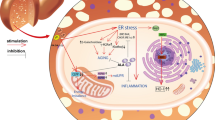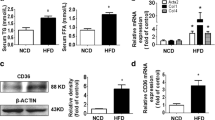Abstract
The presence of cysteine and methionine groups together with an ability to bind long-chain fatty acid (LCFA) oxidation products makes liver fatty acid binding protein (L-FABP) an attractive candidate against hepatocellular oxidative stress. In this report, we show that pharmacological treatment directed at modulating L-FABP level affected hepatocellular oxidant status. L-FABP expressing 1548-hepatoma cells, treated with dexamethasone or clofibrate, decreased and increased intracellular L-FABP levels, respectively. Oxidative stress was induced by H2O2 incubation or hypoxia–reoxygenation. The fluorescent marker, dichlorofluorescein (DCF), was employed to measure intracellular reactive oxygen species (ROS). Hepatocellular damage was assessed by lactate dehydrogenase (LDH) level. Dexamethasone treatment resulted in a significant increase in DCF fluorescence with higher LDH release compared to control cells. Clofibrate treatment, however, resulted in a significant decrease in both parameters (p < 0.05). Drug treatments did not affect cytosolic activites of glutathione peroxidase (GPx), superoxide dismutase (SOD), or catalase suggesting that the differences between treated and control cells may likely be associated with varying L-FABP levels. We conclude that L-FABP may act as an effective endogenous cytoprotectant against hepatocellular oxidative stress.
Similar content being viewed by others
References
Luxon BA, Milliano MT, Weisiger RA (2000) Induction of hepatic cytosolic fatty acid binding protein with clofibrate accelerates both membrane and cytoplasmic transport of palmitate Biochim Biophys Acta 1487: 309–318
Murphy EJ (1998) L-FABP and I-FABP expression increase NBD-stearate uptake and cytoplasmic diffusion in L cells Am J Physiol 275: G244–G249
Martin GG, Danneberg H, Kumar LS, Atshaves BP, Erol E, Bader M, Schroeder F, Binas B (2003) Decreased liver fatty acid binding capacity and altered liver lipid distribution in mice lacking the liver fatty acid-binding protein gene J Biol Chem 278: 21429–21438
Weisiger RA, Zucker SD (2002) Transfer of fatty acids between intracellular membranes: roles of soluble binding proteins, distance, and time Am J Physiol Gastrointest Liver Physiol 282: G105–G115
Thumser AE, Voysey JE, Wilton DC (1994) The binding of lysophospholipids to rat liver fatty acid-binding protein and albumin Biochem J 301: 801–806
Khan SH, Sorof S (1990) Preferential binding of growth inhibitory prostaglandins by the target protein of a carcinogen Proc Natl Acad Sci USA 87: 9401–9405
Woodford JK, Behnke WD, Schroeder F (1995) Liver fatty acid binding protein enhances sterol transfer by membrane interaction Mol Cell Biochem 152: 51–62
Kaikaus RM, Bass NM, Ockner RK (1990) Functions of fatty acid binding proteins Experientia 46: 617–630
Thompson J, Winter N, Terwey D, Bratt J, Banaszak L (1997) The crystal structure of the liver fatty acid-binding protein. A complex with two bound oleates J Biol Chem 272: 7140–7150
Thomas JA, Poland B, Honzatko R (1995) Protein sulfhydryls and their role in the antioxidant function of protein S-thiolation Arch Biochem Biophys 319: 1–9
Levine RL, Mosoni L, Berlett BS, Stadtman ER (1996) Methionine residues as endogenous antioxidants in proteins Proc Natl Acad Sci USA 93: 15036–15040
Ek-Von Mentzer BA, Zhang F, Hamilton JA (2001) Binding of 13-HODE and 15-HETE to phospholipid bilayers, albumin, and intracellular fatty acid binding proteins. implications for transmembrane and intracellular transport and for protection from lipid peroxidation J Biol Chem 276: 15575–15580
Raza H, Pongubala JR, Sorof S (1989) Specific high affinity binding of lipoxygenase metabolites of arachidonic acid by liver fatty acid binding protein Biochem Biophys Res Commun 161: 448–455
Wang G, Gong Y, Anderson J, Sun D, Minuk G, Roberts MS, Burczynski FJ (2005) Antioxidative function of L-FABP in L-FABP stably transfected Chang liver cells Hepatology 42: 871–879
Wang G, Chen QM, Minuk GY, Gong Y, Burczynski FJ (2004) Enhanced expression of cytosolic fatty acid binding protein and fatty acid uptake during liver regeneration in rats Mol Cell Biochem 262: 41–49
Rajaraman G, Burczynski FJ (2004) Effect of dexamethasone, 2-bromopalmitate and clofibrate on L-FABP mediated hepatoma proliferation J Pharm Pharmacol 56: 1155–1161
Swift LM, Sarvazyan N (2000) Localization of dichlorofluorescin in cardiac myocytes: implications for assessment of oxidative stress Am J Physiol Heart Circ Physiol 278: H982–H990
Hasinoff BB (2002) Dexrazoxane (ICRF-187) protects cardiac myocytes against hypoxia–reoxygenation damage Cardiovasc Toxicol 2: 111–118
Barnabe N, Zastre JA, Venkataram S, Hasinoff BB (2002) Deferiprone protects against doxorubicin-induced myocyte cytotoxicity Free Radic Biol Med 33: 266–275
Tollefson KE, Kroczynski J, Cutaia MV (2003) Time-dependent interactions of oxidant-sensitive fluoroprobes with inhibitors of cellular metabolism Lab Invest 83: 367–375
Oberley LW, Spitz DR (1985) Nitroblue Tetrazolium. In: Greenwald RA (eds) CRC handbook of methods for oxygen radical research. CRC Press, Boca Raton, pp 217–220
Lawrence RA, Burk RF (1976) Glutathione peroxidase activity in selenium-deficient rat liver Biochem Biophys Res Commun 71: 952–958
Beers RF, Sizer IW: A spectrophotometric method for measuring the breakdown of hydrogen peroxide by catalase J Biol Chem 195, 1952
Bradford MM (1976) A rapid and sensitive method for the quantitation of microgram quantities of protein utilizing the principle of protein-dye binding Anal Biochem 72: 248–254
Subramaniam R, Fan XJ, Scivittaro V, Yang J, Ha CE, Petersen CE, Surewicz WK, Bhagavan NV, Weiss MF, Monnier VM (2002) Cellular oxidant stress and advanced glycation endproducts of albumin: caveats of the dichlorofluorescein assay Arch Biochem Biophys 400: 15–25
Chan L, Wei CF, Li WH, Yang CY, Ratner P, Pownall H, Gotto AM Jr., Smith LC (1985) Human liver fatty acid binding protein cDNA and amino acid sequence. Functional and evolutionary implications J Biol Chem 260: 2629–2632
Gordon JI, Alpers DH, Ockner RK, Strauss AW (1983) The nucleotide sequence of rat liver fatty acid binding protein mRNA J Biol Chem 258: 3356–3363
Stadtman ER (2004) Cyclic oxidation and reduction of methionine residues of proteins in antioxidant defense and cellular regulation Arch Biochem Biophys 423: 2–5
Vougier S, Mary J, Friguet B (2003) Subcellular localization of methionine sulphoxide reductase A (MsrA): evidence for mitochondrial and cytosolic isoforms in rat liver cells Biochem J 373: 531–537
Dean RT, Fu S, Stocker R, Davies MJ (1997) Biochemistry and pathology of radical-mediated protein oxidation Biochem J 324(Pt 1): 1–18
Ravichandran V, Seres T, Moriguchi T, Thomas JA, Johnston RB Jr. (1994) S-thiolation of glyceraldehyde-3-phosphate dehydrogenase induced by the phagocytosis-associated respiratory burst in blood monocytes J Biol Chem 269: 25010–25015
Manautou JE, Silva VM, Hennig GE, Whiteley HE (1998) Repeated dosing with the peroxisome proliferator clofibrate decreases the toxicity of model hepatotoxic agents in male mice Toxicology 127: 1–10
Nicholls-Grzemski FA, Belling GB, Priestly BG, Calder IC, Burcham PC (2000) Clofibrate pretreatment in mice confers resistance against hepatic lipid peroxidation J Biochem Mol Toxicol 14: 335–345
Mehendale HM (2000) PPAR-alpha: a key to the mechanism of hepatoprotection by clofibrate Toxicol Sci 57: 187–190
Chen C, Hennig GE, Whiteley HE, Corton JC, Manautou JE (2000) Peroxisome proliferator-activated receptor alpha-null mice lack resistance to acetaminophen hepatotoxicity following clofibrate exposure Toxicol Sci 57: 338–344
Vanden Heuvel JP (1999) Peroxisome proliferator-activated receptors (PPARS) and carcinogenesis Toxicol Sci 47: 1–8
Foucaud L, Niot I, Kanda T and Besnard P: Indirect dexamethasone down-regulation of the liver fatty acid-binding protein expression in rat liver. Biochim Biophys Acta 1391: 204–212, 1998
Lawrence JW, Wollenberg GK, Frank JD, DeLuca JG (2001) Dexamethasone selectively inhibits WY14,643-induced cell proliferation and not peroxisome proliferation in mice Toxicol Appl Pharmacol 170: 113–123
Lawrence JW, Wollenberg GK, DeLuca JG (2001) Tumor necrosis factor alpha is not required for WY14,643-induced cell proliferation Carcinogenesis 22: 381–386
Sorof S (1994) Modulation of mitogenesis by liver fatty acid binding protein Cancer Metastasis Rev 13: 317–336
Fridovich I (1983) Superoxide radical: an endogenous toxicant Annu Rev Pharmacol Toxicol 23: 239–257
Munzel T, Afanas’ev IB, Kleschyov AL, Harrison DG (2002) Detection of superoxide in vascular tissue Arterioscler Thromb Vasc Biol 22: 1761–1768
Bennaars-Eiden A, Higgins L, Hertzel AV, Kapphahn RJ, Ferrington DA, Bernlohr DA (2002) Covalent modification of epithelial fatty acid-binding protein by 4-hydroxynonenal in vitro and in vivo. Evidence for a role in antioxidant biology J Biol Chem 277: 50693–50702
Acknowledgments
This work was supported by an operating grant from the Canadian Institute of Health Research. G. Rajaraman gratefully acknowledges support of a University of Manitoba Fellowship Award and the Leslie Buggey Scholarship.
Author information
Authors and Affiliations
Corresponding author
Rights and permissions
About this article
Cite this article
Rajaraman, G., Wang, G.Q., Yan, J. et al. Role of cytosolic liver fatty acid binding protein in hepatocellular oxidative stress: effect of dexamethasone and clofibrate treatment. Mol Cell Biochem 295, 27–34 (2007). https://doi.org/10.1007/s11010-006-9268-6
Received:
Accepted:
Published:
Issue Date:
DOI: https://doi.org/10.1007/s11010-006-9268-6




